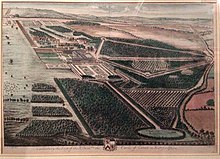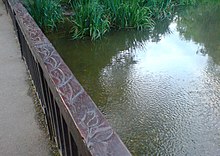Cassiobury Park
| Cassiobury Park | |
|---|---|
 Cassiobury Park | |
 | |
| Type | Public park |
| Location | Watford,Hertfordshire, England |
| Area | 190 acres (0.77 km2) |
| Operated by | Watford Borough Council |
| Status | Open year round |
| Website | watford |
51°39′35″N0°25′0″W/ 51.65972°N 0.41667°W Cassiobury Parkis the principal public park inWatford,Hertfordshire, in England. It was created in 1909 from the purchase by Watford Borough Council of part of the estate of theEarls of EssexaroundCassiobury Housewhich was subsequently demolished in 1927.[1]It comprises over 190 acres (77 ha) and extends from the A412 Rickmansworth Road in the east to theGrand Union Canalin the west, and lies to the south of the Watford suburb ofCassiobury,which was also created from the estate. The western part is a 62-acre (25.1 ha)Local Nature Reservemanaged by theHerts and Middlesex Wildlife Trust.[2][3][4]The park hosts the free, weekly timed parkrun 5 km event every Saturday morning at 9 am, starting on the field near the Shepherds Road entrance to the park, and finishing by the bandstand.[5]
History
[edit]14th to 19th century
[edit]
St Albans Abbeyclaimed rights to themanor of Cashio(then called "Albanestou" ), which included Watford, dating from a grant byKing Offain 793.[6]WhenHenry VIIIdissolved the monasteries in 1539, Watford was divided from Cashio and Henry assumed thelordship of the manorof Cassiobury. In 1546 he granted the manor to SirRichard Morrison,who started buildingCassiobury Housewith the extensive grounds which were much larger than they are today, reaching as far asNorth Watfordand southwards almost toMoor Park.TheTudormansion was completed by his son,Sir Charles Morrison,and boasted 56 rooms, a long gallery, stables, a dairy and a brewhouse.


In 1627 the estate passed into the Capel family through marriage. Arthur Capell, 1st Earl of Essex,commissionedHugh Mayto rebuild the Tudor house, c.1677–80,[7]with sumptuous interiors created in collaboration with thewood carverGrinling Gibbonsand the painterAntonio Verrio.[8]The park and gardens were laid out by Moses Cooke who devised woodland walks and avenues, and provided "an excellent collection of the choicest fruits".[8] Later, the gardenersGeorge LondonandCharles Bridgemanalso worked at Cassiobury. Between 1672 and 1720 an avenue of 296lime treeswas planted, linking the gardens toWhippendell Wood;remnants can still be seen today.


In the late eighteenth century, parts of theGrand Union Canalpassing through the property were widened and landscaped on the insistence ofWilliam Capell, 4th Earl of Essex,who sat on the board of the canal company.
C. 1799–1805, the5th Earl of EssexcommissionedJames Wyattto remodel the house in theGothicstyle, andHumphry Reptonto overhaul the park. Later, a number of lodges and other buildings were constructed by Wyatt's nephew,Jeffry Wyatville;of these, only Cassiobury Lodge in Gade Avenue survives.[9]At this time the park comprised 693 acres (280 ha), the Home Park and the Upper Park being separated by the River Gade. The Upper Park became the West Herts Golf Course.
In 1841 a fire destroyed the orangery, which was filled with newly collected plants and fine orange trees, some of which had been presented to the6th EarlbyLouis XVIII.Herds of deer roamed the park. Parties were a regular feature at the weekends. The public were allowed to ride and walk through the grounds, but had to apply for a ticket in advance.
20th century
[edit]George Capell, 7th Earl of Essexmarried an American heiress, helping to maintain the estate. The parties and entertainments at Cassiobury House continued into the new century: in 1902 it was visited by the youngWinston Churchilland KingEdward VII.But at about this time the Essex family planned to let the house and live in London. The upkeep was becoming increasingly expensive. In 1909, 184 acres (0.74 km2) of parkland were sold, most to Watford Borough Council for housing and the public park. After the 7th Earl's death (1916), his widow and her son, the 8th Earl, sold up in 1922 to pay death duties, and the house was demolished for its materials in 1927.[1] More land for the public park was purchased by Watford Borough Council in 1930.

Construction of the residential Cassiobury Estate began. The land was made subject to restrictive covenants stipulating that only good quality detached or semi-detached houses would be allowed. Most activity was in the 1930s, though building still continues, mostly of "infill" housing on former back gardens. The park is bounded by Parkside Drive and Coningsby Drive on the north, and Cassiobury Park Avenue on the south.
On Thursday 8 June 1922, at 2.30 p.m. at 20Hanover Square,"By direction of the Right HonourableAdèle, Countess Dowager of Essex","Cassiobury Park estate including the historical family mansion, Little Cassiobury, and the West Herts Golf Links, embracing in all an Area of about 870 acres (3.5 km2) "was auctioned by Humbert & Flint, in conjunction with Knight, Frank & Rutley.[10]
Having remained unoccupied and unsold, the house itself was demolished in 1927. Only the stable block remains: this has been converted to Cassiobury Court, a rehab centre for addicts, still extant in Richmond Drive. The grand staircase (said to be designed by Gibbons but since attributed toEdmund Pearce) was removed to theMetropolitan Museum of Artin New York. Other materials from the house were used to restore Monmouth House in Watford High Street. Posters advertised "To lovers of the antique, architects, builders, etc., 300 tons of old oak: 100 very fine old oak beams and 10,000Tudor periodbricks ".[10]
"English country house in New York" inCountry Lifeon Tuesday, 21 July 2009, by Arabella Youens says that salvaged material from the old mansion was used to build a new Cassiobury House in the US:-
- "When Cassiobury House in Hertfordshire, home to the Earls of Essex for more than 250 years, was dismantled in 1927 much of the masonry was used in the construction of a new house of the same name in Bedford, New York."
In 1967, the quaint, castellated entrance gates on the Rickmansworth Road were demolished to make way for a new traffic system.
Little Cassiobury (Grade II* listed), the Cassiobury Estate dower house, still exists in Hempstead Road, Watford. It was sold separately from the rest of the estate. While it was in private ownership it was extended and renovated, in 1937, by the Portmeirion architectClough Williams-Ellis.Soon after that it was compulsorily purchased by Hertfordshire County Council, who built Watford College (latterlyWest Herts College) on part of the site. Herts County Council used Little Cassiobury as an education office for most of the 20th century.
Etymology
[edit]The name "Caegesho" referred to a larger area of land granted byOffato theAbbey of St Albansin 793. "Caeg" (Old Englishcæg) may have been a man's name, while Old Englishhomeans "a spur of land". It was spelled "Caissou" or "Chaissou" in the 11th century and gradually evolved into "Cassio".[11][12] The suffix "-bury"occurs in many English place names. It comes from the Old English word for a fortified place,burh,whose dative,byrig,means "by the fort", or "by the manor".
Layout
[edit]
Much of the park is covered by mown grass and scattered trees. There are notable specimens ofAmerican oakssuch as thepin oakQuercus palustrisMuenchh. and thescarlet oakQ. coccineaMuenchh. Thecedar of LebanonCedrus libaniA. Richard is a prominent feature, though some of the older and unsafe specimens have been removed. Many more recent plantings of exotics have been made, such asswamp cypressTaxodium distichum(L.) Richards and variousAsian rowansSorbusspp.
The park slopes generally downhill from east to west, into the alluvial valley of theRiver Gade.The broadly meandering river and its bridges add much charm; the canal takes a more direct route. The direction of flow is north to south. The Gade is a tributary of theColne,which ultimately flows into theThamesatStaines.

The valley is partly wooded. Some of the woodland is rather wet and gloomy, but very beautiful;alderAlnus glutinosa(L.) Gaertn. is frequent beside the streams. Here also may be found the remains of beds and ditches for growing watercressRorippa nasturtium-aquaticum(L.) Hayek. These are largely silted up and overgrown, but the original springs are still flowing. Beyond the river and canal the ground rises quite steeply to the West HertsGolfCourse, beyond which liesWhippendell Wood.The whole area is freely accessible and surprisingly unspoilt, given its proximity to London, about 20 miles away.
Man-made structures in the park include a complex of paddling-pools and an adjacent miniature railway near the Gade, tennis-courts, abowling green,a system of all-weather asphalt paths, and a number of shelters. TheWatford Miniature Railwayhas a gauge of 101⁄4"and runs for 1010 yards around part of the park. Steam and diesel locomotives are used on passenger trains.
Fauna and flora
[edit]

The bird-life of the formal areas is typical of parkland in southern England. Nuthatches like the old timber; spotted flycatchers the more open ground; and redwings and fieldfares the more open ground yet. Common and black-headed, and sometimes lesser black-backed and herring, gulls form loose flocks on the lower reaches towards the Gade.
The canal, the river and its associated streams provide more interest for the bird-watcher.Teal(Anas crecca),water rail(Rallus aquaticus),grey wagtail(Motacilla cinerea),grey heron(Ardea cinerea) andkingfisher(Alcedo atthis) are regular visitors or resident. Especially in freezing weather, the disused cress-beds can yield waders: most oftensnipe(Gallinago gallinago), but alsoredshank(Tringa totanus) andgreen sandpiper(Tringa ochropus) and, more rarely,jack snipe(Lymnocryptes minimus) anddunlin(Calidris alpina).Water pipit(Anthus spinoletta) may also be found here in winter, and in January 1965, on some cress-ditches which have now been filled in, up to fourspotted crakes(Porzana porzana) were present. The valley is a good place to seewillow tit(Parus montanus),reed bunting(Emberiza schoeniclus), andsedge warbler(Acrocephalus schoenobaenus). The alders attract flocks ofsiskin(Carduelis spinus) andredpoll(C. flammea).Lesser spotted woodpecker(Dendrocopos minor) is frequent.[13] Some of the old ditches and surrounding woodland have been made into a local nature reserve.Marsh marigold(Caltha palustris) grows here, and there is a fairly large bed of great reed-mace (Typha latifolia).
An obvious feature of the riverside flora are three species of balsams: small balsam (Impatiens parviflora), jewel-weed (I. capensis), and policeman's helmet (I. glandulifera). These are said to be escapes from the canal-wharves, where they arrived with consignments of imported timber.
Filming location
[edit]Cassiobury Park has been used as afilming locationin a number of cinema films and television programmes due to its proximity to several major film studios such asElstree Studios.In 1997Whippendell Woodserved as aStar Warsfilming locationwhen it provided the backdrop of a forest on the planetNaboowhich featured in the scene inStar Wars: Episode I – The Phantom Menace,in whichQui-Gon Jinn(Liam Neeson) and his Jedi apprenticeObi-Wan Kenobi(Ewan McGregor) first meetJar Jar Binks(Ahmed Best).[14][15]
References
[edit]- ^abLost HeritageArchived4 September 2014 at theWayback Machine
- ^"Cassiobury Park".Local Nature Reserves. Natural England. 6 October 2014. Archived fromthe originalon 10 February 2015.Retrieved20 April2015.
- ^"Map of Cassiobury Park".Local Nature Reserves. Natural England.Retrieved20 April2015.
- ^"Cassiobury Park LNR".Herts and Middlesex Wildlife Trust. Archived fromthe originalon 3 July 2016.Retrieved20 April2015.
- ^"Cassiobury parkrun | Cassiobury parkrun".www.parkrun.org.uk.Retrieved13 February2019.
- ^William Page, ed. (1908).The hundred of Cashio – Introduction | A History of the County of Hertford: volume 2 (pp. 319–322).Retrieved29 January2013.
{{cite book}}:|work=ignored (help) - ^John Bold,May, Hugh,Oxford Dictionary of National Biography,Oxford University Press,2004; online edn, Jan 2008. Retrieved 3 September 2014
- ^abJohn Evelynvisited Cassiobury on 16 April 1680 and dedicated an insightful passage to the merits and disadvantages of the house and grounds. John Evelyn,Diary and correspondence,Vol. 2,Henry Colburnpublisher, London 1850, pp. 140–141.
- ^Cf. the contemporaryimage of Cassiobury Lodgeonflickr.
- ^abBaty, Patrick."Cassiobury, Hertfordshire".Retrieved31 October2014.
- ^W.R. Saunders (1931).History of Watford.Watford: Peacock. p. 2.
- ^William Page, ed. (1908)."Watford: Manors".A History of the County of Hertford: volume 2.Victoria County History.pp. 451–464.Retrieved13 May2010.
- ^Hertfordshire Bird Report.
- ^"The Park on TV".Cassiobury Park website.Retrieved15 March2012.
- ^"Star Wars trek: Whippendell Woods — November 2001".Star Wars Locations.Retrieved15 March2012.
